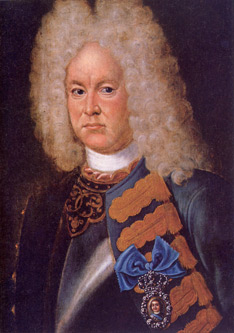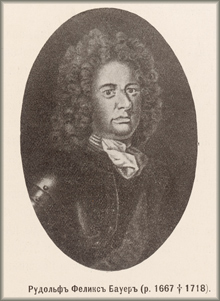|
 Rudolf (Rodion) Frederik Baur (1667Ė1718), General of the Cavalry, and one of the most important military
and tactical advisers and aides of Tsar Peter I during the Great Northern War. The son of an officer from Hinterpommern (Eastern
Pomerania), Baur started his military career in the army of the Duchy of Mecklenburg and later in the army of Prussia. He was soon promoted
to first officer, and by the beginning of the Great Northern War he had risen to the rank of captain. In August of 1700 Rudolf Baur approached
General of the Cavalry Otto Vellingk, the commander-in-chief of all Swedish troops in Ingermanland and Livland, to ask him for protection because
he had been involved in a duel, a punishable offense in Prussia. Although his request was granted, during the siege of the Swedish fortress of Narva
in 1700 Baur changed his allegiance to Russia. He was warmly received by Tsar Peter I, and was sent to Moscow to take command of the Russian
dragoon regiment. Under the general command of Boris Sheremetev, Baurís regiment took part in the battle of Hummelshof (July 1702) against
the Swedish army under the command of General Wolmar Schlippenbach, and in the taking of the fortress of Marienburg in Livland (August 1702).
In May 1703 Baur participated in the taking of the fortress of Nyenkans, located at the mouth of the Neva River, and the founding of St. Petersburg.
Two years later, in 1704, Baurís dragoon regiments took part in the capture of Dorpat and Narva, and soon after that he was sent by the Tsar to
Reval to fight off the Swedish troops under the command of General Wolmar Schlippenbach. In June 1705 Baur's regiment took part in the fighting
near the fortress of Mitawa (Jelgava), the capital of the Duchy of Courland. In October 1706 his troops helped Aleksandr Menshikov to crush the
Swedish-Polish forces under the command of General Arvid Axel Mardefelt near Kalisz. In June 1707, after a long and exhausting siege, Baur
took the fortress of Bykhov, which had been held by a garrison of 3,000 soldiers under the command of the General Kazimierz Krzysztof Sienicki.
Rudolf (Rodion) Frederik Baur (1667Ė1718), General of the Cavalry, and one of the most important military
and tactical advisers and aides of Tsar Peter I during the Great Northern War. The son of an officer from Hinterpommern (Eastern
Pomerania), Baur started his military career in the army of the Duchy of Mecklenburg and later in the army of Prussia. He was soon promoted
to first officer, and by the beginning of the Great Northern War he had risen to the rank of captain. In August of 1700 Rudolf Baur approached
General of the Cavalry Otto Vellingk, the commander-in-chief of all Swedish troops in Ingermanland and Livland, to ask him for protection because
he had been involved in a duel, a punishable offense in Prussia. Although his request was granted, during the siege of the Swedish fortress of Narva
in 1700 Baur changed his allegiance to Russia. He was warmly received by Tsar Peter I, and was sent to Moscow to take command of the Russian
dragoon regiment. Under the general command of Boris Sheremetev, Baurís regiment took part in the battle of Hummelshof (July 1702) against
the Swedish army under the command of General Wolmar Schlippenbach, and in the taking of the fortress of Marienburg in Livland (August 1702).
In May 1703 Baur participated in the taking of the fortress of Nyenkans, located at the mouth of the Neva River, and the founding of St. Petersburg.
Two years later, in 1704, Baurís dragoon regiments took part in the capture of Dorpat and Narva, and soon after that he was sent by the Tsar to
Reval to fight off the Swedish troops under the command of General Wolmar Schlippenbach. In June 1705 Baur's regiment took part in the fighting
near the fortress of Mitawa (Jelgava), the capital of the Duchy of Courland. In October 1706 his troops helped Aleksandr Menshikov to crush the
Swedish-Polish forces under the command of General Arvid Axel Mardefelt near Kalisz. In June 1707, after a long and exhausting siege, Baur
took the fortress of Bykhov, which had been held by a garrison of 3,000 soldiers under the command of the General Kazimierz Krzysztof Sienicki.
 As a result of this victory, which included the capture of 100 enemy guns, Baur was elevated to the rank of general-lieutenant. When Charles XII
launched his Russian campaign and crossed the Dnieper River near Mogilev, one of his advance columns was attacked by Baur's dragoon
detachment near the village of Rajewka and sustained heavy losses. Later General Baur participated in the battle of Lesnaya (September 1708).
In the Battle of Poltava (June 1709) he commanded several dragoon regiments in the fighting near the Russian redoubts. When General-Lieutenant
Rönne, the commander of the Russian cavalry, was wounded, Baur took over command of his troops. After the battle he and Aleksandr
Menshikov followed the retreating enemy to Perevolochna where they disarmed the remaining Swedish troops and took them prisoner.
In appreciation of his distinguished service, Baur received land holdings and a diamond-decorated portrait from the Tsar. From October 1709
till June 1710 Baurís cavalry, under the overall command of Field-Marshal Boris Sheremetev, took part in the siege of the fortress of Riga.
He also participated in later campaigns against the Swedes in Poland and Denmark. He died soon after his promotion in January 1717 to
commander of the division deployed in Ukraine.
As a result of this victory, which included the capture of 100 enemy guns, Baur was elevated to the rank of general-lieutenant. When Charles XII
launched his Russian campaign and crossed the Dnieper River near Mogilev, one of his advance columns was attacked by Baur's dragoon
detachment near the village of Rajewka and sustained heavy losses. Later General Baur participated in the battle of Lesnaya (September 1708).
In the Battle of Poltava (June 1709) he commanded several dragoon regiments in the fighting near the Russian redoubts. When General-Lieutenant
Rönne, the commander of the Russian cavalry, was wounded, Baur took over command of his troops. After the battle he and Aleksandr
Menshikov followed the retreating enemy to Perevolochna where they disarmed the remaining Swedish troops and took them prisoner.
In appreciation of his distinguished service, Baur received land holdings and a diamond-decorated portrait from the Tsar. From October 1709
till June 1710 Baurís cavalry, under the overall command of Field-Marshal Boris Sheremetev, took part in the siege of the fortress of Riga.
He also participated in later campaigns against the Swedes in Poland and Denmark. He died soon after his promotion in January 1717 to
commander of the division deployed in Ukraine.
|
 History
History
 Dates and events
Dates and events
 Persons
Persons
 Poltava
Poltava
 Sights
Sights
 Photo gallery
Photo gallery
 Maps
Maps
 Virtual Museum
Virtual Museum
 Armament
Armament
 Uniforms
Uniforms
 Coins and medals
Coins and medals
 Flags
Flags
 Paintings
Paintings
 Poltava photographs
Poltava photographs
 News
News
 About us
About us
 Acknowledgments
Acknowledgments
 Main page
Main page
 top
top ...back
...back  History
History
 Dates and events
Dates and events
 Persons
Persons
 Poltava
Poltava
 Sights
Sights
 Photo gallery
Photo gallery
 Maps
Maps
 Virtual Museum
Virtual Museum
 Armament
Armament
 Uniforms
Uniforms
 Coins and medals
Coins and medals
 Flags
Flags
 Paintings
Paintings
 Poltava photographs
Poltava photographs
 News
News
 About us
About us
 Acknowledgments
Acknowledgments
 Main page
Main page